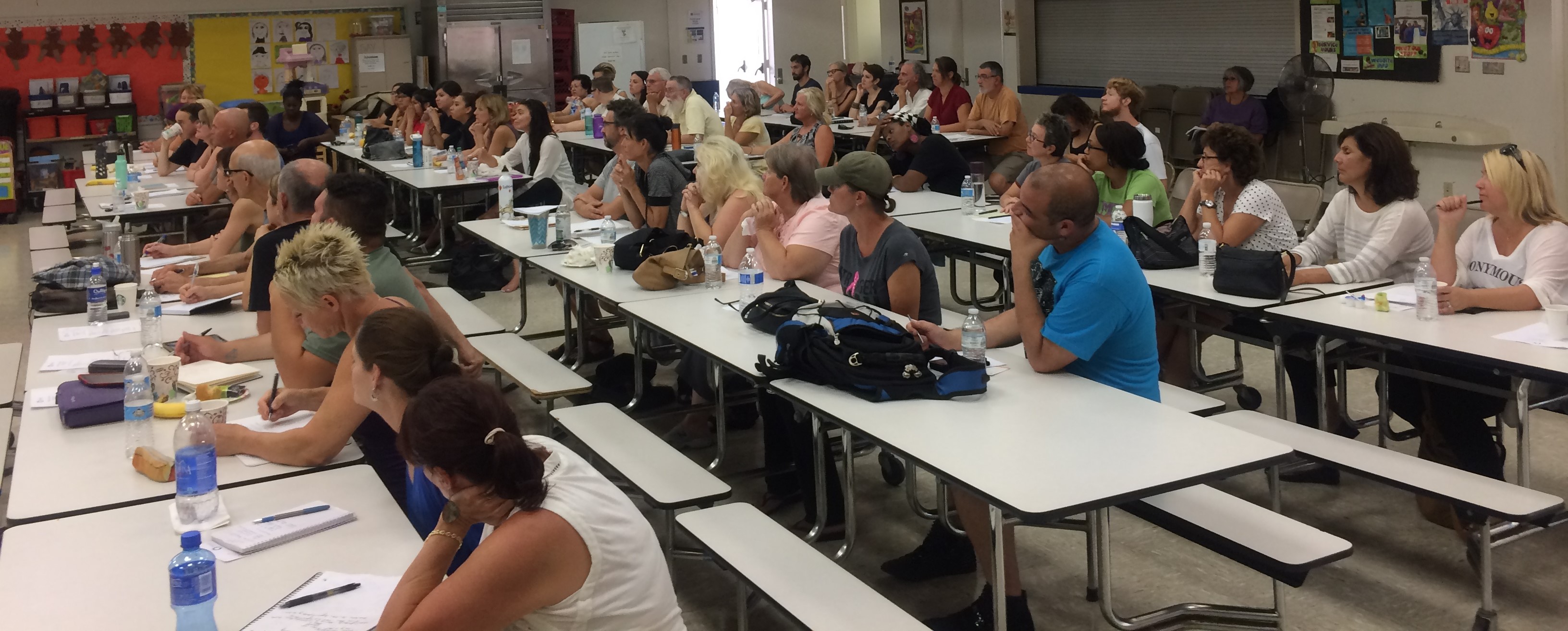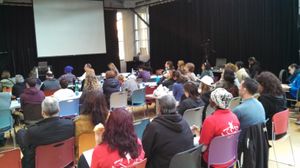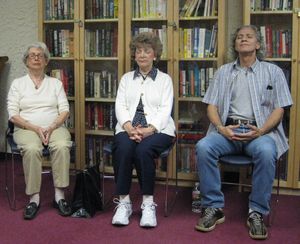FACILITATOR TRAINING - FREE WORKSHOP
Next Train the Trainer will be: TBD
Training is free but limited to 100 people.
Are you interested in learning to lead meditation in your community? The Meditation Initiative hosts facilitator training programs which allows us to bring meditation into the community on a larger scale. Anyone can learn to lead meditation, it is easy. Your ability to communicate with others and facilitate a group is what matters most, no prior meditation experience is necessary. The Meditation Initiative has a unique style of meditation which has been accepted in many public sector environments. Our meditations do not revolve around any religious or spiritual tradition. We received this feedback after the last Train the Trainer Workshop. I think it sums up The Meditation Initiative quite well:
We received this feedback after the last Train the Trainer Workshop. I think it sums up The Meditation Initiative quite well:
"Thanks so much for the great training session on Saturday. I've found myself increasingly disheartened by the barriers (cost, format, etc.) that are traditionally placed on getting meditation to everyday people in their/our everyday lives, and this training was exactly what I needed to see that there's another way! I feel really enthusiastic about the Meditation Initiative's mission to bring these tools into the public sector in a way that is simple, secular and FREE, and hope to be part of this movement." - T.G.
5 Minute Guided Meditation Script - Follow the Script Below to Lead a Meditation Practice
 Prior to Meditation
Prior to Meditation
- Nothing is going to happen to you
- You will not float away
- You will not think nothing
- You will not stop your mind
- You will not have a mystical, magical experience
- You will not solve all of life’s problems in a few moments of silence
- There is no right or wrong way to practice, you simply sit and breathe
- Expect nothing from this experience but to sit and breathe
Posture
- Posture is important, as you want to be comfortable and stay awake
- Keep the back somewhat straight
- Shoulders relaxed
- Hands resting gently on the knees or in lap
- Feet flat on floor
- Eyes closed if comfortable or slightly open, mouth open or closed
- Breathing thru the nose or mouth, whatever is comfortable
- Most important is breathe comfortably
Beginning Meditation
- Start with taking 3 deep breaths
- As you settle into a natural rhythm of the breath, knowing throughout the practice you will hear sounds inside the room, sounds outside, these are not distractions, not disruptions, simply what’s happening around us as we sit and breathe. (30 second pause)
- Begin to notice the mind as it wanders, jumping from thought to thought. Gently guide the attention and focus to the stomach or chest. As you breathe in feel them rise, breathing out feel them fall. (30 second pause)
- Simply continuing this practice, observing sensation of breath (30 second pause)
- The mind continues to wander. Are you stuck in the past? Jumping to the future? Release that thought, returning attention and focus to the breath.(30 second pause)
- Breathing in, follow the breath in, breathing out, follow the breath out (30 second pause)
- The mind wanders, gently guide attention back to the breath (30 second pause)
- Letting go of expectations or judgments of your practice, just sitting and breathing (30 second pause)
- Breathing in, feeling the stomach rise. Breathing out, feel the stomach fall (30 second pause)
- Learning to be comfortable in stillness (30 second pause)
- Knowing what it is like to just sit and breathe (30 second pause)
- Again, taking 3 deep breaths
- Slowly open the eyes, slowly begin to move
 The most important part of practice is right now, after, when you realize that any sort of quiet, still, peace, calm that you feel or any sort of busy thoughts or racing mind you may have now has nothing to do with anything I said, has nothing to do with how you sit or cross your legs and it has nothing to do with the sounds around us. It has everything to do with your own mind and your own mind’s reaction to an external situation. What we realize from the practice of meditation is that things happen and we react, more things happen, more reactions. This is our life every day, every moment regardless of who we are or where we come from. Most people respond to meditation quietly, peacefully. But the question is how do you respond to everything else that happens in your life? For most of us, this feeling is quite different from how we felt an hour ago, or how we will feel an hour from now. What we are working on is closing the gap to where the way we feel now, is closer to how we feel always. Meditation is not easy, it’s not fun, but it’s free and takes nothing but a few minutes and a busy mind, which most of us have. Meditation is not an escape from reality; it is direct perception into your own mind and your own thoughts. When we are in a good mood, it is from thoughts we have, when we are in a bad mood, it is from thoughts we have. Once we stop trying to change everything outside of us and we work on changing our mind and our heart and our reaction to the world around us, life gets a little easier, a little more peaceful, a little happier, yet ultimately nothing changed except our own mind.
The most important part of practice is right now, after, when you realize that any sort of quiet, still, peace, calm that you feel or any sort of busy thoughts or racing mind you may have now has nothing to do with anything I said, has nothing to do with how you sit or cross your legs and it has nothing to do with the sounds around us. It has everything to do with your own mind and your own mind’s reaction to an external situation. What we realize from the practice of meditation is that things happen and we react, more things happen, more reactions. This is our life every day, every moment regardless of who we are or where we come from. Most people respond to meditation quietly, peacefully. But the question is how do you respond to everything else that happens in your life? For most of us, this feeling is quite different from how we felt an hour ago, or how we will feel an hour from now. What we are working on is closing the gap to where the way we feel now, is closer to how we feel always. Meditation is not easy, it’s not fun, but it’s free and takes nothing but a few minutes and a busy mind, which most of us have. Meditation is not an escape from reality; it is direct perception into your own mind and your own thoughts. When we are in a good mood, it is from thoughts we have, when we are in a bad mood, it is from thoughts we have. Once we stop trying to change everything outside of us and we work on changing our mind and our heart and our reaction to the world around us, life gets a little easier, a little more peaceful, a little happier, yet ultimately nothing changed except our own mind.
Video Coming Soon...
TMI FACILITATOR TRAINING PART 1 - MARCH 3, 2013
TMI FACILITATOR TRAINING PART 2 - MARCH 3, 2013




